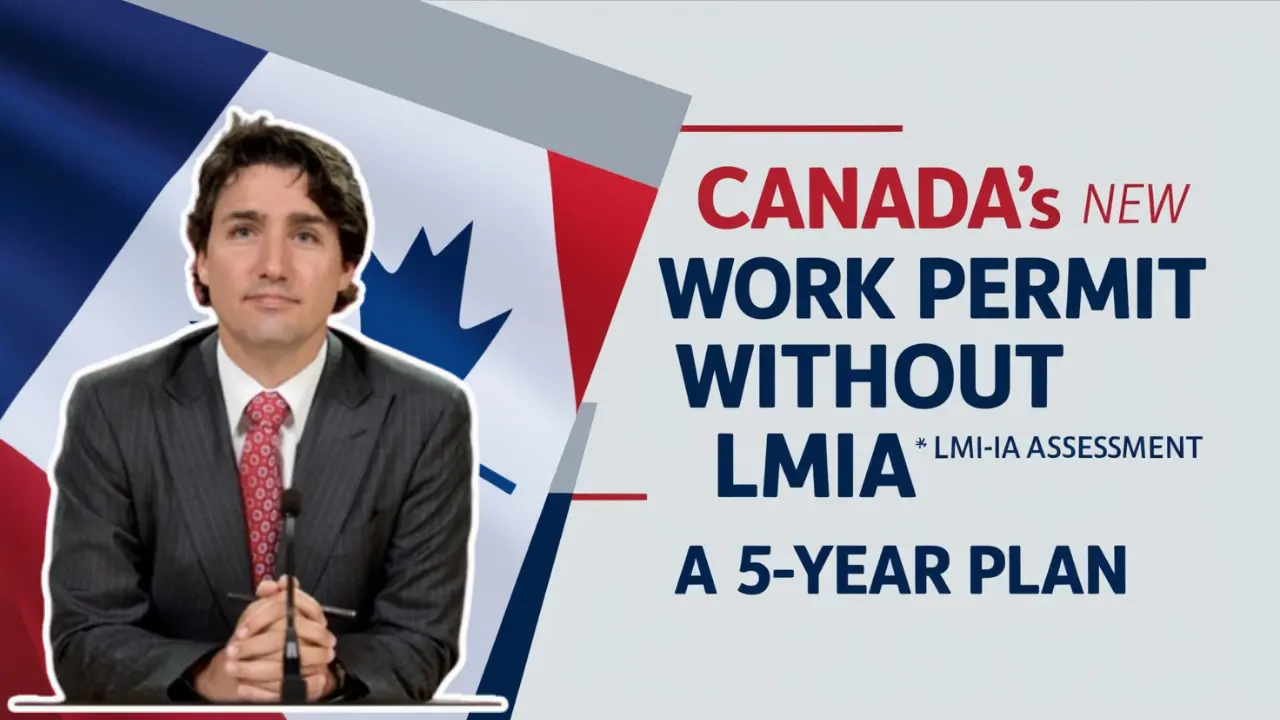Canada New Work Permit System: Canada has introduced a new 5-year work permit plan that eliminates the need for a Labour Market Impact Assessment (LMIA). This change is part of the government’s efforts to attract top global talent and strengthen the economy by simplifying the process for Canadian employers to hire skilled foreign workers in high-demand sectors. The initiative, launched under the Innovation Stream Pilot, is particularly focused on technology and other fast-growing industries, allowing businesses to tap into international expertise with ease.
The Innovation Stream Pilot: Simplified Hiring Process
The new LMIA-exempt work permit is a game-changer for both foreign workers and Canadian companies, especially in rapidly growing sectors. By streamlining the hiring process, cutting down on wait times, and offering long-term work permits, this program makes it easier for businesses to recruit highly qualified talent from around the world. With a clear focus on innovation, the program supports economic growth while offering stability to both employers and employees.
Key Features of Canada’s New Work Permit Plan
| Feature | Details |
|---|---|
| LMIA Exemption | Yes, for eligible employers participating in the Global Hypergrowth Project (GHP) |
| Work Permit Duration | Up to 5 years |
| Program Duration | Pilot phase runs until March 2026 |
| Eligibility | Job offer from a GHP-participating company |
| TEER Categories | NOC TEER 0, 1, 2, and 3 occupations |
| Processing Times | As fast as 2 weeks for TEER 0 and 1 positions |
| Application Platform | IRCC online portal |
| Wage Requirements | Wages must meet or exceed the provincial median wage |
What Is an LMIA?
Typically, Canadian employers must submit a Labour Market Impact Assessment (LMIA) when hiring foreign workers. This process ensures there are no available Canadian workers for the position. However, the LMIA process can be lengthy and costly, creating barriers for fast-growing companies that urgently need specialized talent.
The Innovation Stream Pilot: Key Details
Launched in 2024 as part of the Global Hypergrowth Project (GHP), the Innovation Stream Pilot allows eligible Canadian companies to hire skilled foreign workers without the need for an LMIA. The program is aimed at high-growth industries, especially technology, where there is a shortage of expertise necessary for companies to maintain competitive momentum.
Program Highlights:
- Employer-Specific Work Permits: These permits tie foreign workers to specific employers within the GHP, providing long-term job security for both parties.
- Quick Processing Times: Applications for positions in TEER 0 and 1 (e.g., senior executives, software developers) may be processed in just two weeks.
- Broad Occupation Coverage: The program is open to skilled workers across TEER 0, 1, 2, and 3 categories, including roles such as data scientists, software engineers, and cybersecurity experts.
- No LMIA Requirement: The elimination of the LMIA process reduces time and costs for employers, which is especially beneficial for businesses scaling rapidly.
Eligibility for Canada’s LMIA-Free Work Permit
To be eligible for the LMIA-free work permit under the Innovation Stream Pilot, candidates must receive a job offer from a company participating in the Global Hypergrowth Project. These companies, such as AlayaCare, Clio, and Lightspeed Commerce, are chosen based on their potential to contribute to Canada’s economic growth through innovation.
Foreign workers must meet the following criteria:
- TEER Job Classification: The position must fall under one of the eligible NOC categories (TEER 0, 1, 2, or 3).
- Wage Requirements: The offered salary must match or exceed the provincial median wage.
- Valid Work Status: If already in Canada, applicants must have valid temporary resident status or be eligible to restore their status.
Application Process for Canada’s LMIA-Free Work Permit
Applying for the LMIA-exempt work permit is straightforward. Here’s how the process works:
- Receive a Job Offer: Secure a job offer from a participating GHP company.
- Apply Online: Submit your work permit application via the IRCC Secure Account.
- Skill and Qualification Review: Immigration officers will assess your qualifications to ensure they meet the job requirements.
- Permit Approval: If approved, you will receive a work permit tied to the specific employer.
Once the permit is granted, workers can relocate to Canada and begin their new roles. The 5-year work permit provides long-term stability for both foreign workers and employers.
Impact on Canadian Employers
This new work permit system benefits Canadian employers by streamlining the hiring process and reducing the administrative burden associated with LMIA applications. Companies in industries like technology, which often face talent shortages, will be able to scale faster and more efficiently. The extended work permit duration also provides companies with the flexibility to retain skilled workers long-term without the need for frequent renewals.
Frequently Asked Questions
- What is the Global Hypergrowth Project (GHP)? The GHP is a government initiative that supports rapidly growing Canadian companies by providing access to international talent through a streamlined immigration process.
- Can workers apply for permanent residency after the 5-year work permit? Yes, foreign workers with this permit may be eligible to apply for permanent residency through Canada’s immigration pathways, such as Express Entry or the Provincial Nominee Program (PNP), if they meet the eligibility criteria.
- How fast is the processing for this permit? Processing times for TEER 0 and 1 positions can be as quick as two weeks, offering one of the fastest routes for skilled workers to enter Canada.



